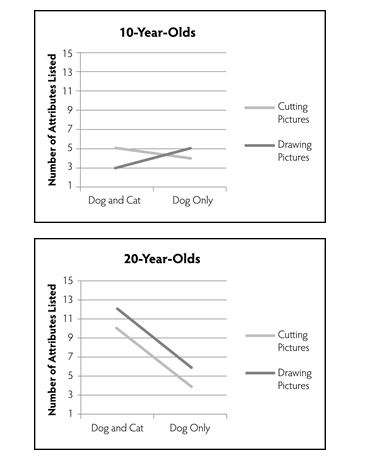RESEARCH STUDY 11.2
(The first paragraph is repeated from earlier. The second paragraph is specific to the new set of questions. The first paragraph is necessary to set up the original study.)
Dr. Elder was interested in the way people recognize objects as members of categories. For example, what makes us recognize a dog as being a dog and not a cat? More specifically, he was curious as to whether people think about categories in a more complex way if they contemplate an "opposite" category first. For example, does a person think more differently about the category of "southern" if they are also thinking about the category of "northern"? He is also curious as to whether people categorize differently if they are exposed to category members compared with generating category members. Dr. Elder has four groups of participants (with 30 people in each group). In Group A, participants were told to cut out pictures of dogs and cats from magazines. In Group B, participants were told to cut out pictures of just dogs from magazines. In Group C, participants were told to draw pictures of cats and dogs. In Group D, participants were told to draw pictures of just dogs. After doing this for 30 minutes, participants in all groups were asked to list the attributes that define the "dog" category. Having a higher number of attributes listed was considered to be an indication of thinking about the category in a more complex way.
Dr. Elder also is curious as to whether categorization happens similarly for children as it does for adults. As such, he recruits a group of 10-year-olds and a group of 20-year-olds to participate in the study. The results are below.

-Refer to Research Study 11.3 above to answer the following question.
Using factorial notation,describe Dr.Lopez's study.Given this information,how many main effects and interactions will Dr.Lopez need to examine?
Definitions:
Early Adulthood
A stage of human development following adolescence, typically characterized by ages 20-40, where individuals establish personal and professional paths.
Midlife
This term refers to the middle period of an individual's lifespan, often characterized by age-related transitions and evaluations of one's achievements and goals.
Technological Medium
Any tool or platform used for the transmission, processing, or storage of information in technological forms.
Adolescents
Young people in the transitional stage of physical and psychological development that generally occurs during the period from puberty to legal adulthood.
Q21: Name the three threats to internal validity
Q27: Another word for discriminant validity is _
Q27: Refer to Research Study 9.3 above to
Q41: Which of the following is NOT an
Q45: Which of the following popular press "headlines"
Q45: Mexico's Yucatán Peninsula was part of the
Q46: Which of the following is NOT an
Q46: Refer to Research Study 3.6 above to
Q52: Figure 2-3 shows that Ciudad Juárez lies
Q62: The world's population is currently estimated to